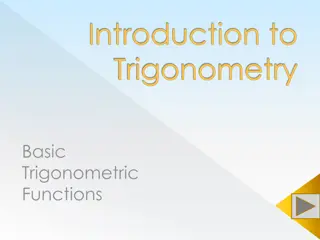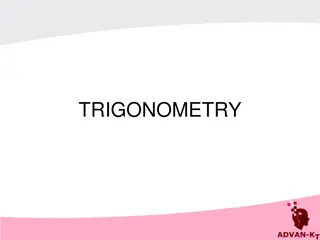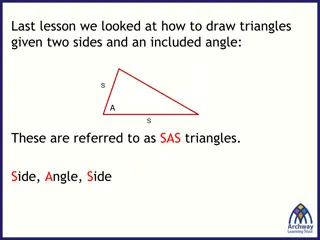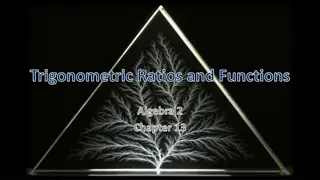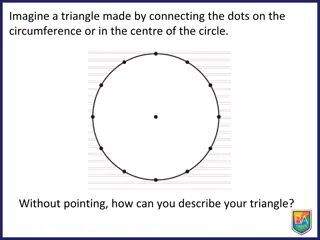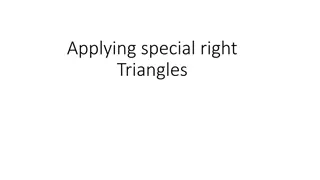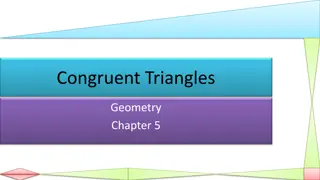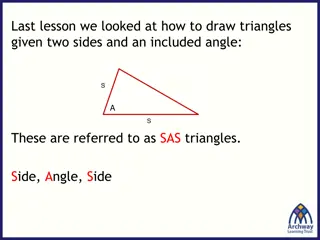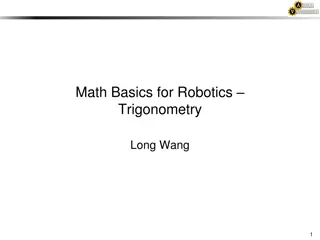Solving right triangles
Discover how to solve right triangles using trigonometric ratios and angle measures. Explore examples and real-world applications, such as calculating street grades in San Francisco. Learn how to identify angles using sine, cosine, and tangent ratios, and use inverse trigonometric functions to find angle measures.
Download Presentation

Please find below an Image/Link to download the presentation.
The content on the website is provided AS IS for your information and personal use only. It may not be sold, licensed, or shared on other websites without obtaining consent from the author.If you encounter any issues during the download, it is possible that the publisher has removed the file from their server.
You are allowed to download the files provided on this website for personal or commercial use, subject to the condition that they are used lawfully. All files are the property of their respective owners.
The content on the website is provided AS IS for your information and personal use only. It may not be sold, licensed, or shared on other websites without obtaining consent from the author.
E N D
Presentation Transcript
Warm Up Use ABC for Exercises 1 3. 1. If a = 8 and b = 5, find c. 2. If a = 60 and c = 61, find b. 11 3. If b = 6 and c = 10, find sin B. 0.6 Find AB. 4. A(8, 10), B(3, 0) 5. A(1, 2), B(2, 6)
Objective Use trigonometric ratios to find angle measures in right triangles and to solve real-world problems.
San Francisco, California, is famous for its steep streets. The steepness of a road is often expressed as a percent grade. Filbert Street, the steepest street in San Francisco, has a 31.5% grade. This means the road rises 31.5 ft over a horizontal distance of 100 ft, which is equivalent to a 17.5 angle. You can use trigonometric ratios to change a percent grade to an angle measure.
Example 1: Identifying Angles from Trigonometric Ratios Use the trigonometric ratio to determine which angle of the triangle is A. Cosine is the ratio of the adjacent leg to the hypotenuse. The leg adjacent to 1 is 1.4. The hypotenuse is 5. The leg adjacent to 2 is 4.8. The hypotenuse is 5. Since cos A = cos 2, 2 is A.
Check It Out! Example 1a Use the given trigonometric ratio to determine which angle of the triangle is A. Sine is the ratio of the opposite leg to the hypotenuse. The leg adjacent to 1 is 27. The hypotenuse is 30.6. The leg adjacent to 2 is 14.4. The hypotenuse is 30.6. Since sin A = sin 2, 2 is A.
Check It Out! Example 1b Use the given trigonometric ratio to determine which angle of the triangle is A. tan A = 1.875 Tangent is the ratio of the opposite leg to the adjacent leg. The leg opposite to 1 is 27. The leg adjacent is 14.4. The leg opposite to 2 is 14.4. The leg adjacent is 27. Since tan A = tan 1, 1 is A.
In Lesson 8-2, you learned that sin 30 = 0.5. Conversely, if you know that the sine of an acute angle is 0.5, you can conclude that the angle measures 30 . This is written as sin-1(0.5) = 30 .
If you know the sine, cosine, or tangent of an acute angle measure, you can use the inverse trigonometric functions to find the measure of the angle.
Example 2: Calculating Angle Measures from Trigonometric Ratios Use your calculator to find each angle measure to the nearest degree. A. cos-1(0.87) B. sin-1(0.85) C. tan-1(0.71) cos-1(0.87) 30 sin-1(0.85) 58 tan-1(0.71) 35
Check It Out! Example 2 Use your calculator to find each angle measure to the nearest degree. a. tan-1(0.75) b. cos-1(0.05) c. sin-1(0.67) tan-1(0.75) 35 cos-1(0.05) 87 sin-1(0.67) 42
Using given measures to find the unknown angle measures or side lengths of a triangle is known as solving a triangle. To solve a right triangle, you need to know two side lengths or one side length and an acute angle measure.
Example 3: Solving Right Triangles Find the unknown measures. Round lengths to the nearest hundredth and angle measures to the nearest degree. Method 1: By the Pythagorean Theorem, RT2 = RS2 + ST2 (5.7)2 = 52 + ST2 Since the acute angles of a right triangle are complementary, m T 90 29 61 .
Example 3 Continued Method 2: Since the acute angles of a right triangle are complementary, m T 90 29 61 . , so ST = 5.7 sinR.
Check It Out! Example 3 Find the unknown measures. Round lengths to the nearest hundredth and angle measures to the nearest degree. Since the acute angles of a right triangle are complementary, m D = 90 58 = 32 . , so EF = 14 tan 32 .EF 8.75 DF2 = ED2 + EF2 DF2 = 142 + 8.752 DF 16.51
Example 4: Solving a Right Triangle in the Coordinate Plane The coordinates of the vertices of PQR are P( 3, 3), Q(2, 3), and R( 3, 4). Find the side lengths to the nearest hundredth and the angle measures to the nearest degree.
Example 4 Continued Step 1 Find the side lengths. Plot points P, Q, and R. PR = 7 PQ = 5 Y By the Distance Formula, P Q X R
Example 4 Continued Step 2 Find the angle measures. Y m P = 90 P Q X The acute s of a rt. are comp. R m R 90 54 36
Check It Out! Example 4 The coordinates of the vertices of RST are R( 3, 5), S(4, 5), and T(4, 2). Find the side lengths to the nearest hundredth and the angle measures to the nearest degree.
Check It Out! Example 4 Continued Step 1 Find the side lengths. Plot points R, S, and T. Y R S RS = ST = 7 By the Distance Formula, X T
Check It Out! Example 4 Continued Step 2 Find the angle measures. m S = 90 m R 90 45 45 The acute s of a rt. are comp.
Example 5: Travel Application A highway sign warns that a section of road ahead has a 7% grade. To the nearest degree, what angle does the road make with a horizontal line? Change the percent grade to a fraction. A 7% grade means the road rises (or falls) 7 ft for every 100 ft of horizontal distance. Draw a right triangle to represent the road. A is the angle the road makes with a horizontal line.
Check It Out! Example 5 Baldwin St. in Dunedin, New Zealand, is the steepest street in the world. It has a grade of 38%. To the nearest degree, what angle does Baldwin St. make with a horizontal line? Change the percent grade to a fraction. A 38% grade means the road rises (or falls) 38 ft for every 100 ft of horizontal distance. Draw a right triangle to represent the road. 100 ft C 38 ft A B A is the angle the road makes with a horizontal line.
Lesson Quiz: Part I Use your calculator to find each angle measure to the nearest degree. 1. cos-1 (0.97) 14 2. tan-1 (2) 63 3. sin-1 (0.59) 36
Lesson Quiz: Part II Find the unknown measures. Round lengths to the nearest hundredth and angle measures to the nearest degree. 4. 5. AC 0.63; BC 2.37; m B = 15 DF 5.7; m D 68 ; m F 22
Lesson Quiz: Part III 6. The coordinates of the vertices of MNP are M ( 3, 2), N( 3, 5), and P(6, 5). Find the side lengths to the nearest hundredth and the angle measures to the nearest degree. MN = 7; NP = 9; MP 11.40; m N = 90 ; m M 52 ; m P 38




